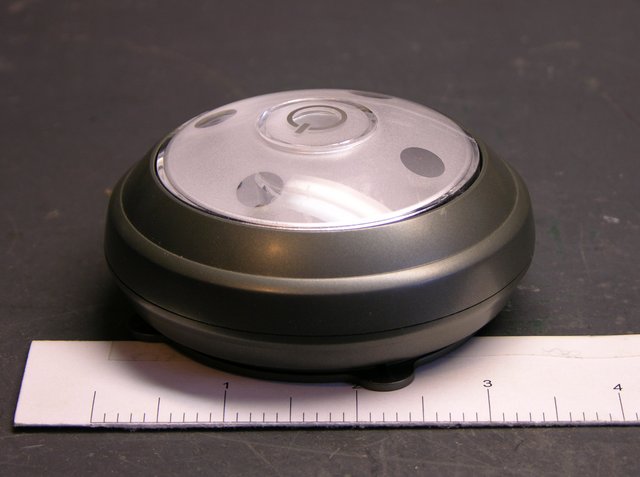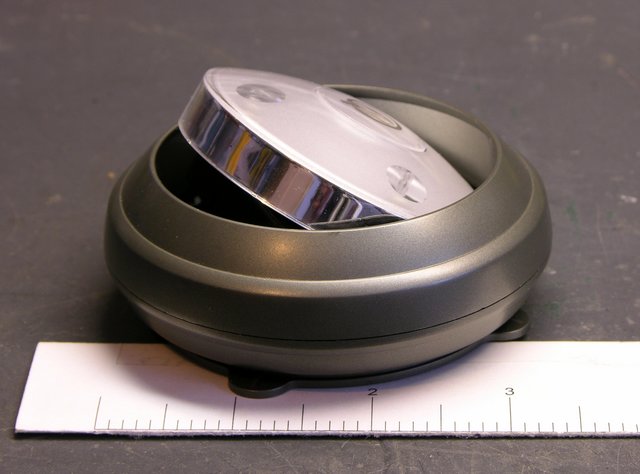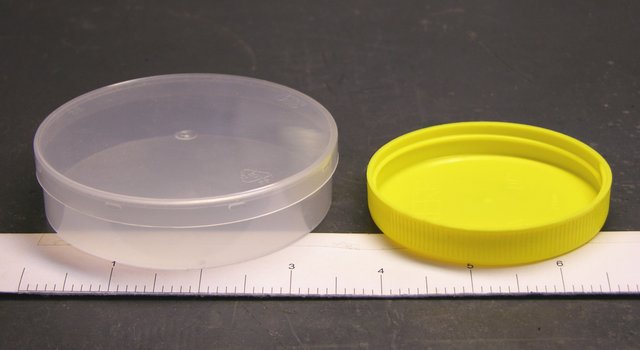Maeve had several of these battery-operated, white LED accent lights, and let me borrow one until the next visit.
It was a good opportunity to test a few ideas about the LED puck. If a commercial product was already on the market, albeit for a different target audience, maybe it’d be good enough and I wouldn’t need to design my own. More likely, I could identify and clarify design differences between their product and my own ideas, which is what turned out to be the case.
First, the LEDs in the commercial puck are pretty directional. When placed on a nightstand pointing at the ceiling, it illuminates about a 2′ diameter area. I’d like the puck to be much more omnidirectional, casting light as evenly as possible throughout a hemispherical area.
Second, it’s not bright enough. Used like a flashlight and pointed directly at a book, it provides more than enough light to read; but pointed upward, the diffusely reflected light isn’t quite enough to read by. I specifically want to be able to read by the light of the puck, and I’d need several more LEDs and somewhat more power to be able to do that.
Third, it’s too bulky, specifically, too thick. I could never carry it in a pocket. I have been carrying it back and forth to work in my laptop satchel, but I realize I’d like the puck (or one version of it) to be small enough to carry with me in a pocket all the time. What’s the point of having cool toys if they’re never with you when you need them?
The light portion of the commercial puck tilts so it can be aimed, and the light portion is actually plenty small to carry around in a pocket. The whole enclosure is larger both to accommodate the tilting action, and because it houses three AAA cells.
The space needed to accommodate a power source concerns me. I’d like to find a flatpack LiPo battery, skinny like a cell phone battery; but I fear that power may be the driving constraint on overall puck size.
Homework Assignment
For anyone reading who’d like to build their own puck, or anyone amused enough by the idea to humor me, I have a homework assignment for you.
Find something round, (*) about the size that you envision the puck being, and carry it with you for a few days. Post a comment about what you used, its dimensions, where on your person you carried it, how comfortable/convenient it was, and whether you’d carry something that size with you all the time.
* (I envision the puck having a rounded profile like a drop of liquid sitting on a horizontal surface, rather than being an untrimmed cylinder. Rounding off the top would slightly improve the comfort of carrying it in a pocket, but cylinders that I’m able to find are good enough for a first test.)
I’ll start:
- I’ve been carrying the commercial LED light in my laptop bag for a week. It’s 3 1/2″ d and just over 1 1/2″ thick. It’s way too thick to fit into a pants pocket; it fits fine in my laptop bag, but then so would a hardback book. I would always have it nearby, although never on my person.
- My first inspiration for the physical form factor of the puck was the empty container from a roll of 3M electrical tape. It’s also 3 1/2″ d but only .9″ thick. It’s still the size that I think would look best for a puck, but it’s uncomfortably large to carry in a pocket, and I haven’t even tried. I would definitely carry it with me in my bag.
- The peanut butter jar lid is 3″ d and 1/2″ thick. I’ve been carrying it in my back jeans pocket since last night, and I hardly notice it’s there; I’d notice it even a little less if the top edge were rounded. This would be a great size for carrying with me all the time — but there’s no way to fit both battery and outward-angled 5mm LEDs into that thickness.
Maybe two puck sizes will be needed — the original puck, in the electrical tape container size, and the porta-puck, in the jar lid size.



I’d like to make a silicone rubber mold of a hockey puck and end up encasing the LED puck to have the side ridges etc of a real puck… Size is a little big to carry around all the time time though, at least not in your pants pocket.
Keith,
I was at a Ham Radio meeting tonight and I thought about your hockey puck idea. Long story short the LSU Physics team lost one of their balloon payloads. They have GPS tracking radios on them but they only last about 8 hours.
I was thinking about some sort of time delay device that would activate after the payload returned. There would be either a single high brightness LED that was attached to some sort of 360 degree diffuser or multiple high brightness LED. It would pulse every 15 or 30 seconds depending on how the battery life is.
Another feature would be a piezo beep that alternated with the LED for a more even battery drain.
Thoughts?
Kris, my friend Cort has prototyped a high-intensity red LED strobe to mount on top of his house — maybe on one of the ham antennas — to flash at the sky so he can identify his house when he flies over. I wonder whether something like that would be useful — is there any chance of aerial reconaissance?
Tell me more about the balloons. How long do they stay aloft, that eight hours tracking on a GPS won’t do the job? How do you detect when the payload has returned — just wait long enough? What about adding another GPS radio on a time delay to transmit location after it’s landed? How large an area are they searching?
And, are you sure this isn’t just an excuse to get me to figure out the USB interface and LiPo power management ICs I got, so I can finish the puck?
I visited their website and they don’t have the details of ACES10 up yet which is the one that they lost. The LSU team did a great presentation last night at the meeting. In a nutshell, here is what they think happened:
Based on the tracking data from the 2 APRS beacons, they speculate that the payload (a 50′ or so string with multiple packages attached to it about 5′ apart) encountered turburlance as it crossed 50K feet. Data shows that it was coming down about four times faster then ACES9 which was launched a few minutes prior. At around 20K feet and within 5 minutes of each other, ALL radio transmitters ceased functioning. Speculation here is that the package, now damaged and spinning on it’s decent slung what was left of the wire antennas.
They have a very narrow search area that they spent a good deal of time searching for the package. However, the schedule forced them to stop. These are students and volunteers. They have printed up REWARD posters with maps and photos and local law enforcement, game wardens, etc are all willing to keep a look out.
The total flights on these are only suppose to last about 30 minutes max as I remember. In the videos of the launch, you can hear a morse beacon but I am not sure if that was being emitted from a nearby radio or the tracker itself.
I was thinking that a visual indicator and a chirp emitter that was on a 30 minute delay would aid in the recovery of future flights. Obviously weight is a factor but they are powering the experiments off of 9V Lithium batteries.
Here is the link to the program: http://laspace.lsu.edu/aces/index.html
Specs of ACES10: http://laspace.lsu.edu/aces/FlightInfo/2007-2008/ACES-10/ACES10_Flightinfo.htm
Ultimately the goal is to get the student’s experiments back. They weren’t overly concerned with the radio gear.
kw
Kris, I’m thinking about a tiny circuit that would charge a capacitor to a trigger point, then dump the capacitor through a set of high-intensity LEDs. That should allow you to power the system with a lower-capacity battery than one with enough current to power the LEDs directly.
It’d be slick if there were a way to attach the LEDs to a small helium balloon on a 5′ tether, to get them up above the height of weeds, fences, etc. I don’t see any way that could be done without the balloon and tether getting tangled in the main line, though.
A chirp should be doable, although I expect you’d be able to see flashing LEDs from further away than you could hear a chirp. Still, if the LEDs are on the ground, they may be hard to spot.
I just bought a batch of ATtiny25s — cute little eight-pin microcontrollers at about $1 each in quantities of 25. Seems to me that might make a nice platform to build something that would wait 30 minutes (reprogrammable) and then start flashing every 15 seconds (also reprogrammable). You could also toggle an output pin to drive a piezo chirper.
Where would you like to go with this? Is this something you’d like to build for them? Looking for help, or just ideas? Would they even be interested in outside contributions?
BTW, congrats on your Projector repair making it to Hack-A-Day. Forgot to send you a congrats on that.
The students seem to have no lack of talent. What I would like to do is to brainstorm some qualified solutions for them and then turn it over to the students for the construction and programming. I just met the gentleman in charge of the project last night so it is not like I am “part of the project”.
I think us Hams and electronics buffs can offer some suggestions but I don’t want to do the work for the students. I think that this is all part of the learning process.
kw
Kris, I don’t have a BlinkM and haven’t tried their software, but I bet you could program one to sleep for 30 minutes and then flash periodically. It wants 5V, but one could look up the ATtiny’s datasheet and see what kind of range it can accept. So that might be another option.